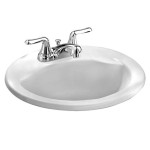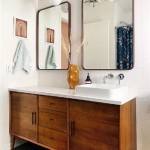Bathroom Vanity With Sink Ideas: A Comprehensive Guide
The bathroom vanity, a combination of a sink and storage, serves as a focal point in the bathroom. It provides a functional space for washing, grooming, and storing essential toiletries. The selection of the right bathroom vanity with a sink is crucial for optimizing both the aesthetic appeal and the practical utility of the bathroom. This article delves into various bathroom vanity ideas, considering different styles, materials, sizes, and sink configurations to guide the user in making an informed decision.
The functionality of a bathroom extends beyond its basic purpose. It acts as a personal oasis, a sanctuary for relaxation and rejuvenation. The vanity unit is central to this experience, and its design should reflect the individual's preferences and needs. From minimalist floating vanities to elaborate traditional designs, the market offers a diverse range of options to suit varying tastes and bathroom layouts.
Understanding Different Vanity Styles
The style of a bathroom vanity significantly influences the overall ambiance of the space. Selecting a style that complements the existing architectural features and the homeowner's personal aesthetic is essential for creating a cohesive and visually appealing bathroom.
Traditional Vanities: These vanities often feature ornate details, raised panel doors, and classic hardware. They are typically constructed from solid wood, such as oak or cherry, and finished with rich stains or paints. Traditional vanities often incorporate features like decorative moldings, turned legs, and intricate carvings, evoking a sense of timeless elegance. The sinks used in traditional vanities may be undermounted or drop-in, and often feature porcelain or ceramic materials.
Modern Vanities: Characterized by clean lines, minimalist designs, and a focus on functionality, modern vanities often incorporate sleek materials like glass, metal, and engineered wood. They tend to prioritize storage efficiency with features like pull-out drawers, hidden compartments, and integrated lighting. Modern vanities frequently utilize vessel sinks, creating a striking visual statement. Color schemes are often neutral, with an emphasis on grays, whites, and blacks.
Contemporary Vanities: Blending elements of both modern and traditional styles, contemporary vanities offer a balanced aesthetic that is both stylish and functional. They may incorporate natural materials like wood and stone, while maintaining a clean and uncluttered appearance. Contemporary vanities often feature unique shapes, asymmetrical designs, and innovative storage solutions. Color palettes can range from muted earth tones to bold accent colors, allowing for greater personalization.
Farmhouse Vanities: Embodying rustic charm and a connection to nature, farmhouse vanities typically feature distressed finishes, reclaimed wood, and simple hardware. They often incorporate shaker-style doors, open shelving, and apron-front sinks. Farmhouse vanities emphasize functionality and practicality, with ample storage space for everyday essentials. The color scheme is often inspired by natural elements, with whites, creams, and muted greens predominating.
Floating Vanities: Also known as wall-mounted vanities, these units are attached to the wall, creating a sense of spaciousness and airiness in the bathroom. Floating vanities are particularly well-suited for smaller bathrooms, as they maximize floor space and facilitate cleaning. They often feature minimalist designs and sleek hardware, and can be customized with various materials and finishes.
Choosing the Right Vanity Material
The material of a bathroom vanity directly impacts its durability, maintenance requirements, and overall appearance. Selecting a material that is both aesthetically pleasing and resistant to moisture and humidity is crucial for long-term performance.
Solid Wood: Known for its durability and natural beauty, solid wood is a popular choice for bathroom vanities. However, it is susceptible to moisture damage if not properly sealed and maintained. Common types of wood used for vanities include oak, maple, cherry, and walnut. Solid wood vanities offer a warm and inviting aesthetic and can be stained or painted to match any décor.
Plywood: A more affordable alternative to solid wood, plywood is a composite material made from layers of wood veneer. It is more resistant to warping and cracking than solid wood, making it a suitable choice for bathrooms with high humidity levels. Plywood vanities can be finished with a variety of veneers, paints, or laminates to achieve different looks.
MDF (Medium-Density Fiberboard): MDF is an engineered wood product made from wood fibers and resin. It is smooth, even, and easy to paint or laminate. MDF is less expensive than solid wood and plywood, but it is also less resistant to moisture damage. However, it is less sturdy than plywood. MDF vanities should be sealed properly to prevent water absorption.
Laminate: Laminate is a synthetic material made from layers of paper and resin. It is durable, water-resistant, and easy to clean. Laminate vanities are available in a wide range of colors, patterns, and textures, making them a versatile choice for any bathroom style. Laminate is also relatively inexpensive, making it a budget-friendly option.
Stone: Materials like granite, marble, and quartz are often used for vanity countertops. These materials are durable, water-resistant, and add a touch of luxury to the bathroom. Stone countertops can be paired with a variety of vanity bases to create a custom look. However, stone countertops can be expensive and require proper sealing to prevent staining.
Metal: Stainless steel and other metals are sometimes used in modern and contemporary vanities. Metal vanities are durable, water-resistant, and easy to clean. They offer a sleek and industrial aesthetic and can be paired with a variety of sink materials and styles.
Exploring Sink Configuration Options
The sink configuration is a critical aspect of bathroom vanity design, influencing both the functionality and the aesthetics of the space. Various sink types are available, each with its own advantages and disadvantages.
Undermount Sinks: These sinks are installed beneath the countertop, creating a seamless and clean look. Undermount sinks are easy to clean and maintain, as there are no rims or edges to trap dirt and debris. They also maximize counter space, providing more room for grooming and other activities. Undermount sinks are a popular choice for both modern and traditional bathrooms.
Drop-In Sinks: Also known as self-rimming sinks, these sinks are installed into a pre-cut hole in the countertop. The rim of the sink rests on the countertop, providing a finished edge. Drop-in sinks are relatively easy to install and are available in a wide range of sizes, shapes, and materials. They are a versatile choice for any bathroom style.
Vessel Sinks: These sinks sit on top of the countertop, resembling a bowl or basin. Vessel sinks are a stylish and eye-catching accent and can add a touch of personality to the bathroom. They are available in a variety of materials, including glass, ceramic, stone, and metal. Vessel sinks require a taller faucet to accommodate their height.
Console Sinks: These sinks feature a basin supported by legs, creating a freestanding structure. Console sinks offer a vintage or traditional aesthetic and are often found in older homes. They may or may not include storage space beneath the sink. The open design of console sinks can create a sense of spaciousness in the bathroom.
Wall-Mounted Sinks: Similar to floating vanities, wall-mounted sinks are attached directly to the wall, without the support of a cabinet or legs. This design maximizes floor space and creates a minimalist aesthetic. Wall-mounted sinks are a good choice for small bathrooms or for those seeking a clean and uncluttered look. Plumbing fixtures are typically exposed with wall-mounted sinks.
Trough Sinks: These long, rectangular sinks are designed to accommodate multiple users simultaneously. Trough sinks are a popular choice for large bathrooms or for shared spaces. They are available in a variety of materials, including stainless steel, concrete, and ceramic. Trough sinks can be either undermounted or surface-mounted.
Beyond the style, material and configuration, considerations such as faucet selection, plumbing compatibility, and adherence to building codes are crucial. Faucet finishes should complement the sink material and the overall bathroom design. Ensuring compatibility with existing plumbing lines is essential to avoid costly alterations. All installations must comply with local building codes and regulations.
Ultimately, the selection of a bathroom vanity with a sink is a multifaceted decision that requires careful consideration of style, material, configuration, and practical factors. By understanding the various options available, users can select a vanity that enhances the functionality, aesthetics, and overall value of their bathroom.

25 Single Sink Bathroom Vanity Design Ideas

Beautiful Bathroom Vanity Ideas Forbes Home

New This Week 5 Stylish Single Sink Bathroom Vanity Areas

25 Single Sink Bathroom Vanity Design Ideas

27 Bathroom Vanity Ideas

21 Best Bathroom Vanity Ideas 2024 See Our Top Picks
:max_bytes(150000):strip_icc()/258105_9352cff4942f41ca9a569fd19719f30cmv2-1dbb8e2d34e447f1a8ec34f831615b76-37ea3a19ffd34f79b043ef86535a3778.jpeg?strip=all)
26 Bathroom Vanity Ideas That Are Stylish And Functional

10 Bathroom Vanity Ideas To Jump Start Your Remodel

Pin On Contemporary Decorating Ideas

15 Small Bathroom Vanity Ideas That Rock Style And Storage
Related Posts







